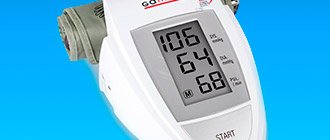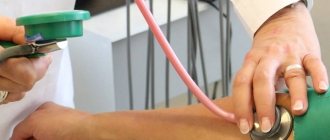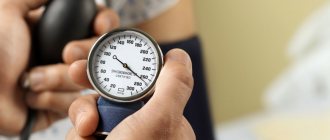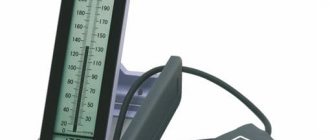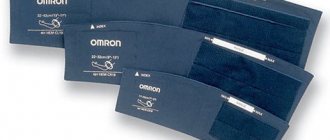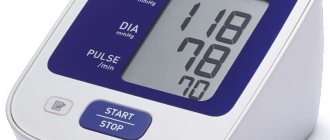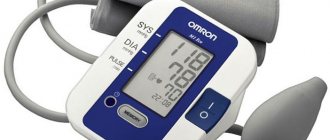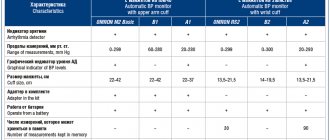Blood pressure (blood pressure) is an indicator indicating how much pressure blood exerts on the walls of blood vessels as it passes through them. The numbers depend on the elasticity of the vessels themselves and the pumping function of the heart muscle. This indicator is considered vital and requires regular monitoring. There is a device that allows you to measure blood pressure (BP) at home and in the hospital - a tonometer. The device can be mechanical, semi-automatic and automatic. Mechanical models are more often used. Next, we discuss how to measure pressure with a mechanical tonometer and how to interpret the results.
Step-by-step instruction
How to measure blood pressure correctly with a mechanical tonometer:
- Take a sitting position (a sofa or armchair is suitable for this).
- Lean your back on the back of the chair, and place your feet on the floor (it is not recommended to cross them, tuck them in, throw them on top of each other, etc.).
- The left hand is freed from clothing and placed on a table or any other flat surface. The main thing is that it is not in a canopy.
- Open the cuff, insert your hand into it and secure it slightly above (2-3 cm) the elbow bend.
- Place part of the stethoscope in the form of a small metal disk on the inside of your elbow. It is important that the pulsating artery is clearly felt in this place.
- If you are performing this procedure for the first time and do not yet fully understand how to correctly measure pressure with a mechanical tonometer, then first feel the pulse with your fingers. For the future, you will know exactly where to place the metal part of the stethoscope.
- Then insert the hearing aid stethoscope into your ears.
- Make sure the air release wheel on the bulb is tightly closed.
- Place the rubber bulb of the tonometer in your hand and begin manually supplying air. The arrow on the dial will begin to move. After it reaches the 200-220 mm mark. rt. Art., stop squeezing the bulb and slowly begin to spin the wheel. The air should come out slowly, about 4 mmHg. Art. per second.
- As the air descends, you should hear a pulse. The number where the needle will be on the first beat is your systolic pressure (i.e., top). The pulse will be heard for some time. The value at which the needle will be at the last beat is your diastolic blood pressure (i.e., lower).
- Measure blood pressure on the other arm. Consider higher values as reliable. In the future, measure the pressure on the arm where it is higher.
- Both results obtained must be written down or remembered.
In general, this process will take you a few minutes. This procedure must be carried out daily, recording the data obtained. Thus, you can determine the average values of your upper and lower pressure.
Decoding the results
The pressure gauge scale is divided into mmHg. Art. Minimum – 0 mm Hg. Art., and a maximum of 300 mm Hg. Art. Indicators above 200 mm Hg. Art. are considered critical and require immediate medical attention. One section of the scale corresponds to 2 mmHg. Art. When recording results, you must indicate two indicators, which are separated by the “/” sign. Examples of normal blood pressure: 110/70 mmHg. art., 125/80 mm Hg. Art.
If, when measuring your blood pressure, the readings are higher than normal, it is important to repeat the procedure after 5 minutes to check whether the increased blood pressure is associated with emotional experiences, physical activity or other physiological reasons. According to medical data, normal systolic pressure is a figure in the range of 91–139 mmHg. Art., diastolic – 61–89 mm Hg. Art. It is important to remember that a number of features of the body may slightly increase or decrease the permissible limits, and this will be considered the norm.
An increase in blood pressure is called hypertension, a persistent increase is called arterial hypertension. A decrease in levels is called hypotension. Both conditions can be at a safe or critical level. In the latter variation, the patient will need immediate medical attention.
Technique for measuring blood pressure with a mechanical tonometer
Technique for measuring blood pressure with a mechanical tonometer
Note! Hypertension - why are blood pressure pills harmful? Dr. Bubnovsky about two safe and simple steps to life without hypertension Read more »
To measure your blood pressure, you need to perform a series of sequential steps:
- Sit at the table, placing the hand being examined on its surface, palm up.
- Wrap the cuff loosely around your shoulder with the hoses facing down. Secure it with Velcro.
- If the device comes with a phonendoscope, then insert its ends into your ears, and attach the head with the membrane to the place of the strongest pulsation, usually located on the inside of the elbow joint. If there is no phonendoscope, blood strokes will have to be determined visually, guided by the sensations in the hand.
- Screw the valve on the bulb all the way and use your free hand to inflate the cuff with air until you feel numbness in your shoulder and the pulsation stops. At the same time, watch the pressure gauge needle: it should reach a value of 20–30 mm Hg. Art. higher than your normal blood pressure.
- Slowly open the bulb valve. At this point, you will hear a series of beats (about 8-10 in total) corresponding to your heartbeat. Remember to look at the meter dial: the needle will quickly move in the opposite direction, towards zero. You should see what mark it will be at when you hear the first and strongest impulse of blood - this is the value of systolic, or upper, blood pressure.
- The pulse beats will gradually subside. The last audible beat of the series corresponds to the lower (diastolic) pressure. For example, if you heard the first beat of blood when the needle was at 140, and the last one was at 90, then your blood pressure is 140/90 mmHg. Art.
- When finishing the measurement, open the bulb valve completely and release all the air from the cuff.
Having certain experience and skill, using a hand-held tonometer for measuring pressure with a phonendoscope, you can measure these indicators on the leg, if necessary. The point of most audible vascular pulsation is located on the outside of the dorsum of the foot.
Preparing for measurement
First of all, you need to check the condition of the pressure measuring device. The needle on the pressure gauge should be at o, and the air from the cuff should be released. If the arrow is not at “0”, you can take the device to a specialist in the field of medical technology. He will manually set up the device, calibrating it according to the readings of a mercury tonometer.
What does upper pressure mean?
In a home environment there is usually only one device. When purchasing it, it was important to choose the optimal cuff size. In a hospital setting, medical workers choose from all available devices the one whose cuff fits the patient’s arm size. Before measuring a patient’s blood pressure, it is important to explain to him the essence of the procedure. Professionals should do this even if they believe that the patient is unconscious. It is important to inform the patient that a blood pressure cuff will be placed on their arm and that slight pressure will be felt.
If the patient is conscious, you should inform him that during the procedure you cannot talk, stand up, or change the position of your hand. It is also necessary to clarify what medications the patient is taking, whether he drank alcohol, or smoked a quarter of an hour before the diagnosis.
Important! In case of a nervous condition, you need to give the patient time to calm down so that the results are reliable.
The patient must be seated or positioned. When sitting, the hand on which measurements will be taken should be located at the level of the heart muscle. The hand must be freed from clothing, but so that the sleeve does not pinch above the place where the cuff is applied.
During the measurement, the subject's hand should lie on a hard horizontal surface and be bent.
Diagnostic technique
You need to relax and be silent
How to correctly measure blood pressure with a mechanical tonometer? An inflatable cuff with a balloon is fixed on the shoulder at the site of pulsation of the brachial artery. The lower edge of the cuff should not reach the elbow (2 cm from it).
You must first free your hand from clothing. Initially, a palpation method of examining blood pressure is performed. Air is quickly inflated into the cuff to a level of 70 mmHg. Art. on the pressure gauge, then gradually increase the air pressure in the balloon by 10 mm until the pulse on the radial artery completely disappears. Then the air is gradually released until a pulse appears.
This method helps prevent overinflation of the cuff in the presence of the phenomenon of auscultation failure.
After the palpation method of recording pressure, the auscultatory method is carried out. To take measurements you will need the same thing and a phonendoscope.
The phonendoscope should be placed at the level of the ulnar fossa (a little higher and closer to the middle). Gradually pump air into the balloon so that the pressure in the cuff exceeds the pressure at which the pulse in the artery disappears by 20-30 mmHg. Then they open the valve a little and monitor the Korotkoff sounds and their changes.
- How to correctly measure blood pressure with an electronic tonometer: measurement technique
Electronic models
Electronic blood pressure monitors operate using the oscillometric method. In their case, the use of a stethoscope is not required, the total numbers will be automatically shown on the screen. Measuring pressure with an electronic tonometer is extremely convenient for people with poor hearing and vision. One of the advantages is the ability to determine the number of heartbeats and the presence of arrhythmia. The results obtained can be saved in the device memory. Unlike a mechanical tonometer, even a child can use an electronic device, since measuring blood pressure is very simple and sometimes just pressing 1-2 buttons is enough.
An electronic tonometer can be automatic or semi-automatic. In the first case, it is enough to put on the cuff and press the button to start determining blood pressure. Semi-automatic blood pressure monitors are cheaper, but you have to pump the air manually. After reaching the required pressure, the device itself releases air.
The following algorithm will help you understand how to correctly measure pressure using semi-automatic tonometers:
- fix the cuff 3 cm from the elbow;
- pump air until the device is tightly connected and stop;
- look at the final result shown on the display.
With an automatic tonometer, the procedure is even easier. How to measure pressure correctly can be seen below:
- Fix the cuff and press the button located on the display.
- After completing the operation of the device, look at the display to familiarize yourself with the result.
Hand-held device
A manual tonometer for measuring pressure is an air-filled cuff with Velcro, connected by hoses to a rubber pump - a bulb and a meter (manometer). The cuff is wrapped around the patient's shoulder and fastened. The bulb is equipped with a screw-on valve. By compressing it several times, air is pumped into the cuff.
The most common breakdown of a mechanical tonometer is a violation of the seal of the bulb: the bulb bursts, or an invisible crack appears on it over time, which requires replacement of this part of the device.
In addition, some devices come with a phonendoscope for listening to blood impulses in the arteries. These blood pressure monitors are certainly more convenient.
Common Mistakes
Below is a list of the most common errors that can lead to an incorrect result after measuring blood pressure, and as a result, to an erroneous diagnosis:
- Incorrect preparation for blood pressure measurement. It is very important not to overload your body with physical activity before the procedure (including brisk walking and light jogging).
- Rolling up sleeves. In this case, the wrapped fabric compresses the hand, cutting off natural blood circulation, which will lead to an incorrect result. The best solution would be to put on a T-shirt or short-sleeved sweater in advance. But if you have already come to a medical facility with a long sleeve, then you can simply pull your hand out of it.
- The cuff is the wrong size. It is important that the size of the blood pressure monitor cuff matches the circumference of your arm. When measuring blood pressure, it should fit your hand tightly and not slip off.
- Hand position. Your hand should be on a horizontal surface, approximately at the same level as your heart. It is unacceptable for it to droop or strain. This will give a false result.
We hope that this information will help you understand the question of how to measure pressure with a mechanical tonometer. It is enough to carry out the procedure yourself several times or apply the acquired theoretical knowledge on your loved one. You will succeed!
Read in this article:
- Design and principle of operation of a mechanical tonometer
- Automatic blood pressure monitor device
- How does an automatic blood pressure monitor measure blood pressure?
- Features of wrist tonometers and semi-automatic devices
- How to choose the right tonometer?
- Convenient and accurate instruments for measuring pressure
Blood pressure is an important indicator of the functioning of the circulatory system, the heart and the entire body as a whole. To measure this parameter, instruments called tonometers are used. They differ in the principle of operation and functionality, in design and method of use. To choose the right device for home use, it is worth understanding how the tonometer works and how it is designed.
Is it possible to measure for yourself?
Often people have to measure their blood pressure levels themselves at home. The order of measurements remains unchanged, the only difference is that the stethoscope must be pressed with a cuff to leave the hand free to pump air with the bulb.
Choosing a mechanical tonometer provides the opportunity to most accurately monitor the course of illnesses, identifying complications in people suffering from disorders of the heart and blood vessels, and the use of the above-described algorithm and recommendations helps resolve issues that may arise with the purchase of a mechanical device.
Subscribe to TechnoCouncil on social networks so you don’t miss anything:
Advantages and disadvantages
Advantages of mechanical tonometers:
- Small price.
- High accuracy.
- They fail less often.
- All components are interchangeable.
- Does not depend on power sources.
- Light weight and compact.
Also, mechanical tonometers have one significant drawback - to use a mechanical tonometer, you must have good hearing and a certain skill in measuring blood pressure, otherwise the whole procedure of measuring your own pressure will not make any sense. However, this problem can be solved if you ask a knowledgeable person to measure your blood pressure, and at the same time he will show you how to do it correctly.
During these same years, invasive 24-hour blood pressure monitoring also became part of the practice of clinical and physiological work. The method was called "Oxford". It involves continuous recording of blood pressure through a catheter inserted into the brachial artery. A miniature infuser provides flushing of the catheter with heparinized saline solution. The pressure sensor signal is continuously recorded on magnetic tape. This technique represents the most accurate way to measure blood pressure in an outpatient setting. However, taking into account the potential risk of complications (infection, bleeding, damage to the median nerve, etc.), as well as the presence of a stress factor in a patient with a corresponding pressor component, this method is not widely used in scientific and clinical practice.
Non-invasive devices with built-in microcompressors (less commonly, gas cartridges) and a fully automated measurement process appeared in the late 60s. Almost all of them reproduced the blood pressure measurement algorithm using the Korotkov method.
In 1976, Criticon created and marketed the first bedside automatic blood pressure monitor that successfully implemented a modified Marey oscillometric method (Dinamap 825). When measuring blood pressure using this method, the pressure in the occlusive cuff is reduced gradually (in steps of 6–8 mm Hg or linearly) and the amplitude of pressure micropulsations in the cuff that occurs when arterial pulsations are transmitted to it is analyzed. The dependence of the pulsation amplitude on the pressure level in the cuff has a characteristic bell-shaped shape. Its analysis allows you to determine the values of systolic, average and diastolic pressure. The first is usually taken to be the pressure in the cuff, at which the sharpest (fastest) increase in the amplitude of pulsations occurs, the second corresponds to the maximum pulsations, and the third corresponds to a sharp weakening of pulsations (Fig. 1). However, the exact operating algorithms of devices, as a rule, are not disclosed by manufacturers. Some devices use algorithms based on the analysis of the first derivative of pulsations, i.e. tachooscillometer options.
The Dinamap device was successfully verified when compared with categorization data and became a prototype for a new type of blood pressure meters - oscillometric. Since the 80s, this method has also found application in wearable 24-hour blood pressure monitors.
Currently, devices based on the oscillometric method make up about 80% of all automatic and semi-automatic blood pressure meters. Among wearable 24-hour monitors, this percentage drops to 30%, with auscultatory methods represented in 38% of monitors, and a combination of methods accounting for 24% of devices (K. Ng, 1994).
Each method has its own advantages and disadvantages.
Auscultatory method (according to N.S. Korotkov).
Advantages
a) Today it is recognized as the official standard for non-invasive blood pressure measurement for diagnostic purposes and for verification of automatic blood pressure meters.
b) Has increased (relative to oscillometric) resistance to hand movements. Especially when “tying” the analysis of sound phenomena to the R-wave of an ECG, using two or more microphones, and using complex spectral algorithms for recognizing the useful signal. For example, the Accutracker 2 device successfully performed about 93% of blood pressure measurements under bicycle ergometer testing conditions.
Flaws.
Sensitive to room noise, accuracy of microphone placement relative to the artery, rotation of the cuff with microphones on the arm during long-term monitoring, requires direct contact of the cuff or microphone with the patient’s skin.
Oscillometric method of measuring blood pressure.
Advantages.
a) Relatively resistant to noise loads, which allows it to be used in situations with high noise levels (up to the helicopter cockpit).
b) Allows you to determine blood pressure in cases that present a problem for the auscultatory method - with a pronounced “auscultatory failure”, “endless tone”, weak Korotkoff tones.
c) Pressure values are practically independent of the rotation of the cuff on the arm and little dependent on its movements along the arm (until the cuff reaches the elbow).
d) Allows you to measure blood pressure without loss of accuracy through thin clothing.
Flaws.
Relatively low resistance to hand movements. Thus, the SL90202 device did not provide blood pressure measurements during a HEM test in 82% of measurements.
Both methods are ineffective for severe heart rhythm disturbances. In this situation, it is extremely difficult for a doctor to determine blood pressure, since the very algorithm for implementing the technique, acceptable for irregular heartbeats, is problematic.
In recent years, new noninvasive methods for determining blood pressure have attracted increasing attention.
In 1969, Czech researcher J.Penaz received a patent for a method that is usually referred to as “volume-clump” in English-language literature. In the domestic literature, this and similar methods are called compensatory (less commonly, unloaded artery methods). It is based on continuous assessment of the volume of the blood vessels of the finger using photoplethysmography and the use of an electro-pneumatic tracking system to create a pressure in the cuff surrounding the finger that counteracts the stretching of the arterial vessels passing under the cuff. If the last condition is met and the diameter of the finger arteries is constant, a constant tensile pressure close to zero is maintained in them, and the pressure in the cuff “repeats” the blood pressure in the arteries of the finger. Thus, the device provides a unique opportunity for long-term recording of the entire blood pressure curve by non-invasive means, which was previously only possible using the invasive Oxford method. A stationary device that implements this method is known as Finapres, and a recently created wearable device is Portapres (I and
II). The latter involves placing cuffs on two fingers and alternating them to eliminate unpleasant sensations in the patient during daily monitoring. The device has a blood pressure correction system for hydrostatic correction that occurs when the fingers are positioned differently relative to the level of the heart. Unfortunately, the method is not without fundamental drawbacks. The measured value of diastolic blood pressure is lower than in the brachial artery, and the correction depends on the vasospastic state of the arteries of the finger. Systolic blood pressure tends to be higher than brachial artery blood pressure in younger subjects but lower in older subjects. The correction also depends on the tone of the arteries. The weight of the device with batteries is more than 2 kg, and it is significantly more expensive than traditional blood pressure monitors.
The tonometry method, first described by Pressman and Newgard in 1963, involves partial compression of the superficial arteries of the limb (for example, at the wrist) and recording, using strain gauges, the lateral pressure transmitted to them through the vessel wall. Currently, a commercially produced bedside version of the Colin Pilot 9200 device is being tested. Interest in this method is associated primarily with the expected combination - continuous recording of blood pressure - low level of tactile influences - reasonable price.
The accuracy of blood pressure measurement is one of the key characteristics of pressure measuring devices.
To determine it, clinical trials are carried out, during which the measurements of the device are compared with the reference ones. The latter may be invasively measured pressure or pressure measured by the Korotkoff method by two experts. Methods for conducting tests and processing results are regulated by national and international standards and protocols (European (En1063-3), Germany (58130), FDA (USA), etc.). However, the most popular protocols remain AAMI/ANSI (USA) and BHS (UK). According to the AAMI/ANSI protocol, the average difference in blood pressure values determined by the device and experts should not exceed 5 mm Hg, and the standard deviation should not exceed 8 mm Hg. According to the BHS protocol, after testing, the device is assigned an “accuracy” class according to a table of the frequency of observed differences between the device readings and the BP values determined by two trained medical professionals.
| About | cent of differences pr | boron and expert | high blood pressure | |||
| Class | <5 mmHg | <10 mmHg | <15 mmHg | |||
| A | 80% | 90% | 95% | |||
| IN C | 65% 45% | 85% 75% | 95% 90% | |||
To fully comply with BHS requirements, a device must be rated at least I/V, and devices with characteristics worse than C are not recommended for use.
According to the recommendations of the fourth international consensus conference on the problems of 24-hour blood pressure monitoring in outpatient settings (1994), for ABPM it is preferable to focus on devices that have successfully passed testing according to the above-mentioned protocols in leading medical institutions (with the publication of the results obtained).
The recommendations of both mentioned protocols formed the basis of the clinical trial protocol used when testing blood pressure meters in the Department of New Diagnostic Methods and Research of the Research Institute of Cardiology named after. A.L.Myasnikova RKNPK Ministry of Health of the Russian Federation.
Here are some devices that have successfully passed clinical testing (according to O'Brien et al as of 01.1995, A.N. Rogoza et al. as of 01.1998).
| Test reports | |||||
| Device | Type | AAMI/ | B.H.S. | RKNP | |
| ANSI | TO | ||||
| CH-DRUCK | A | + | A/A | ||
| Profilomat | A | + | B/A | ||
| Nissei DS-240 | A/O | + | B/A | ||
| Quiet Trak | A | + | B/B | ||
| SpaceLabs | |||||
| SL-90202 | ABOUT | + | B/B | ||
| SL-90207 | ABOUT | + | B/B | + B/B | |
| AND | |||||
| TM-2420 mod.6 | A | + | B/B | ||
| TM-2420 mod.7 | A | + | B/B | ||
| TM-2421 | A/O | + | B/A | ||
| Mobil-O-Graph | ABOUT | + C/B | |||
| BP-3400 | A/O | +C/A | |||
| ABPM-02 | O | + B/B | |||
| Note: A - auscultatory, O - oscillometric methods used in the device | |||||
When choosing a device, it is also important to consider that the noise from the compressor in
night time can reduce the quality of sleep and even completely interrupt the patient’s sleep, delaying the process of waking up in the morning. Such episodes are accompanied by a rise in blood pressure by 5-25 mm Hg. At the same time, in devices with a reduced EEG noise effect, signs of sleep phase disturbances during blood pressure measurements, as a rule, are not observed.
The air cuff is also an important part of the device. According to WHO recommendations (1993), a standard cuff for adults should have an internal pneumatic chamber 13 to 15 cm wide, 30 to 35 cm long and covering at least 80% of the perimeter of the limb. For patients with a limb perimeter of more than 32 cm and less than 22 cm, it is necessary to switch to cuffs of increased and decreased sizes in order to prevent overestimation and underestimation of blood pressure values.
A simplified version of monitoring using semi-automatic devices.
The relatively high cost of devices for 24-hour blood pressure monitoring and the research itself make it difficult to widely introduce analysis of the 24-hour blood pressure profile into widespread medical practice. At the same time, in recent years, mass-produced and relatively inexpensive semi-automatic blood pressure meters have become available for sale.
Is it possible to use “household” devices to study the blood pressure profile (“self-monitoring”)?
1. It is possible to evaluate only the daytime blood pressure profile, since waking up at night to take blood pressure measurements will inevitably cause an artifactual rise in pressure and distort the results.
2. Preference should be given to devices with automatic inflation of air into the cuff. Manual air injection in semi-automatic devices may be accompanied by a temporary increase in blood pressure
3. Devices for measuring blood pressure on the wrist and finger are less accurate than brachial ones. Correction values can differ significantly from person to person (and even change sign); they significantly depend (especially for finger meters) on the severity of vasospastic manifestations. 4. It is necessary to focus only on devices that have undergone comprehensive clinical trials. According to the magazine of the US Consumer Society (October 1996), good results in this regard were demonstrated by the A&D UA-767, Omron HEM-711, A&D UA-702, Omron HEM-712C, Lumiscope 1085M models (shown in the order of increasing total scores of consumer properties). Devices from Omron and A&D with automatic inflation of air into the cuff and the location of the occlusion cuff on the shoulder demonstrated high accuracy in clinical trials according to the BHS protocol in the RKNPK (B/B and A/A).
When using “household” appliances, it is necessary to take into account that:
a) even the best automatic devices of this class cannot claim to replace the traditional blood pressure measurement according to N. S. Korotkov’s method for diagnostic purposes; the latter remains the only officially approved method for diagnosis and assessment of the effect of treatment;
b) in approximately 3-7% of cardiac patients, automatic meters give blood pressure values that consistently differ from the traditional medical definition of blood pressure by more than 10 mm Hg. and control comparisons for each patient are necessary for correct orientation to the data of automatic devices.
An example of instructions for the patient, a sample form for recording blood pressure values during “self-monitoring” and a version of the daily blood pressure profile obtained as a result of the study are given in the appendix.
Control (verification) measurements.
Both with daily monitoring with special devices and with the use of semi-automatic devices, before the start of each monitoring it is necessary to carry out a series of control (verification) measurements, with simultaneous (or sequential) determination of blood pressure by the device and a qualified medical specialist. In the absence of blood pressure asymmetry, measurement is carried out on the “non-dominant” arm. When asymmetry is more than 5 mm Hg. - on the arm with higher blood pressure values. Control measurements are carried out in a sitting position, phases I and V of Korotkoff sounds are recorded, the pressure in the cuff is measured with mercury or certified dial gauges. At least 4 consecutive measurements are recommended with an interval of at least 2 minutes (after the end of the previous one). Based on the last three measurements, the average instrumental and “medical” blood pressure values are calculated. If their difference is more than 5 mm Hg. for DBP and 10 mmHg. for SBP, it is necessary to check the correct application of the cuffs and the orientation of the microphones (with the auscultation method). If better agreement cannot be achieved, it is recommended to move the cuff to the other arm or use a device with a different method of determining blood pressure. With persistent differences in blood pressure values exceeding the above values, interpretation of monitoring results is problematic. However, programs for analyzing ABPM results, developed at the RKNPK, make it possible to introduce corrections for identified differences. Similar programs are supplied with the BP3400 and TM2421 instruments.
In many ways, successful blood pressure monitoring depends on the patient’s behavior and his desire to help the doctor identify his characteristic pattern of pressure changes during the day. If the patient perceives the monitor as an annoying necessity, and during the measurement he strains his arm and moves his fingers in order to endure another unpleasant moment associated with shoulder compression, then almost any device will not be able to provide reliable information about the daily pressure profile of this patient.
It is important to explain to the patient the essence of the study, its significance for the selection and control of therapy, features of operation, precautions provided in the device to prevent excessive compression, etc. The APPENDIX provides an example of instructions that it is advisable to give to the patient along with a behavior diary during monitoring.
Keeping an activity diary during monitoring is necessary to assess the degree of psycho-emotional and physical stress, and to clarify the causes of episodic increases and decreases in blood pressure. When interpreting blood pressure variations during sleep, it should be taken into account that turning from one side to the other changes the hydrostatic component of blood pressure in the brachial artery by 10 mm Hg. Art. The APPENDIX provides a sample of a patient diary developed in the NMDI department of the RKNPK.
The practice of conducting research shows that a certain percentage of patients, despite instructions, treat this element of the study quite freely. To radically solve this issue, the TM-2425 system (A&D, Japan) provides an electronic activity sensor and a body position sensor. Special devices called “actigraphs” are also produced.
Processing the results.
When analyzing the daily blood pressure profile obtained as a result of monitoring, at least four main groups of indices (indicators) are used, the connection of which with the initial blood pressure values is demonstrated by the diagram in Fig. 2.
1. Time-average indicators and their analogues.
This most important group of indicators includes the average values, medians and modes of blood pressure measurements obtained during the day, day, night and other selected time intervals.
Most researchers and programs accompanying 24-hour blood pressure monitors use arithmetic mean blood pressure values as average values, determined by the formula:
where BP(24) is the average pressure value for 24 hours, P^ is the pressure value at i-
m dimension, N is the total number of dimensions.
| Here ADcorr(24) is the corrected average pressure value, A ti is the interval |
| between measurements. Note that to determine the average (over time) value, it is most correct to use the formula: la and end of monitoring, T - total monitoring time. In the processing programs used in RKNPK, it is the latter formula that predicts blood pressure values between measurements by linear interpolation. |
Similar formulas are used for other time intervals. The arithmetic mean value of dynamically changing quantities gives a correct estimate of the time average or average integral value only at equal intervals between measurements. Taking this into account, recently a number of processing programs have begun to use a modification of the above formula to take into account the difference in the intervals between blood pressure measurements, for example, during the day and night hours:
Comparison of arithmetic mean and mean integral values.
An analysis of the data bank of daily monitoring of the RKNPK (more than 3000 observations in patients with predominantly mild and moderate forms of hypertension) showed that when the ratio of the duration of daytime and nighttime intervals between measurements is 1:2 (for example, 15/30 min), the formula for calculating arithmetic average values leads to an overestimation average systolic blood pressure per day SBP(24) by 1.91 +0.16 mmHg. and diastolic - DBP(24) - by 1.50 +0.10 mm Hg. (p<0.001).
The magnitude of the correction is related to the degree of difference between night and day blood pressure values, and for a separate study can be calculated using the formula:
where a is the ratio of the duration of night and day, b is the ratio of the daytime interval between measurements to the nighttime one, 8 is the ratio of the average nighttime pressure to the daytime one. Its relatively low value allows us to recommend using the formula of arithmetic averages when analyzing individual daily profiles, and taking into account corrections only for group types of analysis. When analyzing blood pressure separately in daytime and night time intervals, the arithmetic mean and mean integral values do not differ significantly.
A number of authors suggest using blood pressure median values instead of (or in addition to) arithmetic averages, which, in their opinion, will allow high-amplitude artifactual emissions to be excluded from the analysis.
However, in most programs for analyzing 24-hour monitors, including the programs of the SL90207, Mobilogragh, TM2421 and BP3400, ABPM-02 devices, there are restrictions on the permissible blood pressure values (the so-called auto-rejection limits), which largely eliminate high-amplitude artifacts. Meanwhile, analysis of the data bank showed that the average deviation of the median blood pressure values from the integral average is +2.29 + 0.28 mm Hg. for SBP(24) and +2.41+0.24 mmHg. for DBP(24) (p<0.001). Thus, median averages overestimate the average integral indicators. In a comparative analysis, median indicators did not demonstrate either increased reproducibility or stability with an increase in the number of unsuccessful measurements and varying intervals between measurements. This allows us to consider their advantages highly controversial.
Modes of distribution of AD values are also present in the processing programs of a number of equipment manufacturers, but to date they have not found any widespread use and do not pretend to replace the average integral values.
Recommendations
Often people do not know how to use a manual blood pressure monitor or a semi-automatic device. Let's look at some recommendations:
- People over 40 years of age are recommended to purchase automatic blood pressure monitors; devices on the wrist will not accurately reflect the readings, since the arteries in this area are quite worn out in older people.
- For patients suffering from cardiovascular diseases, it is better to purchase a tonometer that measures not only blood pressure, but also pulse.
- If the device is used by two family members, you should pay attention to models that store the data of two users.
- A tonometer with a fan-shaped cuff does not cause discomfort during use; it fits tightly to the arm, as a result of which blood pressure readings are not distorted.
- The cuff must not be secured over clothing or the device must be turned on until it is worn.
- During the procedure, you should not talk or strain.
- For people with poor vision, tonometers have been developed that pronounce the measurement results, and devices with an intelligent control function are also commercially available. Thanks to special sensors, they give a signal if the procedure is performed incorrectly.
In the article we looked at how to use a tonometer. It is worth saying that the correctness of the noted indicators depends on the correct use of the device. If a person is in doubt, then it is necessary to talk with a doctor and clarify the nuances of using a tonometer.
How to measure your own blood pressure?
If necessary, a person can independently measure his or her blood pressure using this type of tonometer. The procedure is no different from the instructions described above. Only the phonendoscope is fixed with the edge of the cuff.
To ensure the accuracy of the indicators, the procedure can be repeated several times with a difference of about five minutes.
In the online store “A-Ya Zdorov” you can purchase high-precision devices for monitoring blood pressure at an affordable price. Go to selection.
How to choose the cuff size?
The cuff includes a fabric cover, a built-in rubber bladder and Velcro for fixation. The cuff is attached to the shoulder or wrist. Cuffs come in different sizes and differ in circumference (coverage). To get accurate readings when measuring blood pressure, you need to select the size so that the length of the pneumatic chamber does not differ much from the circumference of your arm.
On the packaging, the size is always indicated in two numbers, for example: 20-40 centimeters. It is necessary to purchase a cuff in which the specified range corresponds to the circumference of the arm. To determine the size of the shoulder, you need to correctly measure the girth between the collarbone and the antecubital fossa. The cuff is sold in three standard sizes: S - children's, M - medium, L - large.
The wrist blood pressure monitor also has a cuff. But since it is small in size, it cannot be worn by overweight people, although it is also produced in three versions, like the shoulder cuff.
